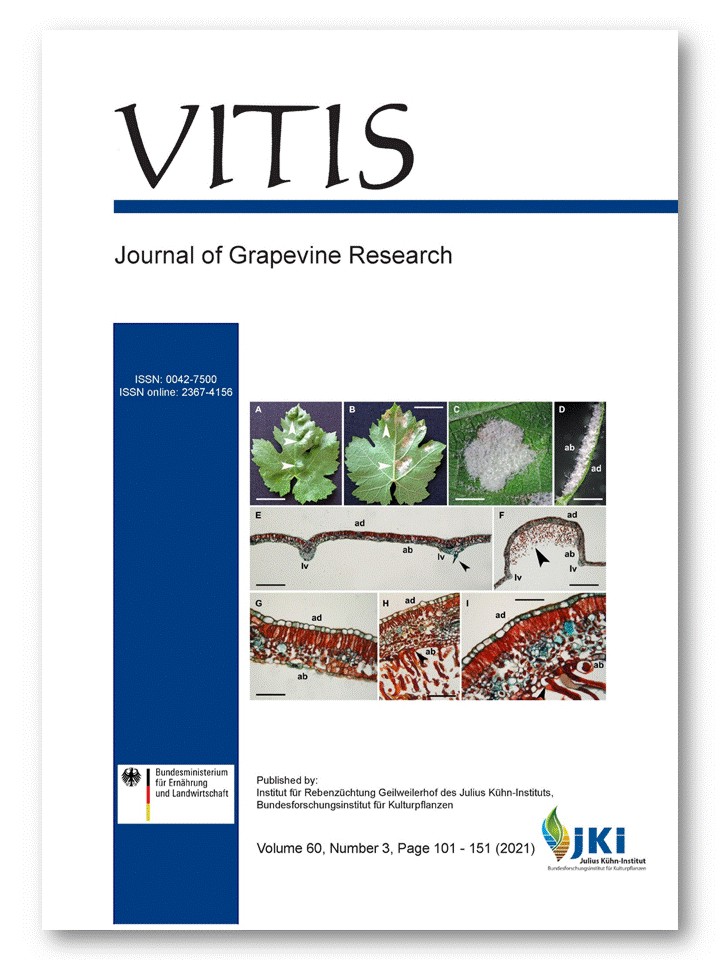Erinea in the 'Ansonica' grapevine cultivar: trichome complement, histological effects and analysis of chlorophyll fluorescence in affected leaves
DOI:
https://doi.org/10.5073/vitis.2021.60.101-108Abstract
Grapevine leaves are usually characterized by trichomes, specialized epidermal cells. They are interesting in ampelography and also important for the plant ecological responses in biotic and abiotic interactions. In nature, the trichome development is a genetic trait but it can be modified by pests as eriophyid mites. Colomerus vitis is quite common and its economic value is sometime substantial. Here, we studied the leaf erineum induced by C. vitis on 'Ansonica' ('Inzolia'), an important grapevine cultivar characterized by a low level of leaf trichome coating. To date, the interaction between C. vitis and grape has been investigated in few pedo-climatic conditions and no data are reported in 'Ansonica'. Therefore, our objectives were: (1) the analysis, in a Tuscan environment, of the morphology and histology of trichomes in 'Ansonica' leaves unaffected or affected by C. vitis; (2) evaluation, in mature leaves, of the effects of the mite both on pigment content and chlorophyll a fluorescence parameters. 'Ansonica' was devoid of glandular trichomes but it has been established the presence of few simple trichomes strictly associated with the veins. In the erineal sectors, a dense proliferation of simple trichomes in the abaxial epidermis and the development of hyperplasia in the adaxial surface were observed. Moreover, the leaf sections in the erineal regions were thicker due to an abnormal development of the lacunar parenchyma, and trichome proliferation was also extended to interveinal regions. Leaves with erinea showed a deficient content of carotenoids, in comparison to unaffected leaves. In 'Ansonica' leaves, C. vitis induced a decrease in the steady-state operational efficiency of photosystem II associated to a reduction in photochemical quenching and an increase in non-photochemical quenching values. In leaves with erinea, the reduction of photosystem II efficiency was extended to foliar areas not directly affected by galls. The collected results highlight that 'Ansonica' is susceptible to attacks by C. vitis and in the case of widespread leaf attacks the productive damage should not be underestimated.
Downloads
Published
Issue
Section
License
Copyright (c) 2021 The Author(s)

This work is licensed under a Creative Commons Attribution 4.0 International License.
The content of VITIS is published under a Creative Commons Attribution 4.0 license. Any user is free to share and adapt (remix, transform, build upon) the content as long as the original publication is attributed (authors, title, year, journal, issue, pages) and any changes to the original are clearly labeled. We do not prohibit or charge a fee for reuse of published content. The use of general descriptive names, trade names, trademarks, and so forth in any publication herein, even if not specifically indicated, does not imply that these names are not protected by the relevant laws and regulations. The submitting author agrees to these terms on behalf of all co-authors when submitting a manuscript. Please be aware that this license cannot be revoked. All authors retain the copyright on their work and are able to enter into separate, additional contractual arrangements.



